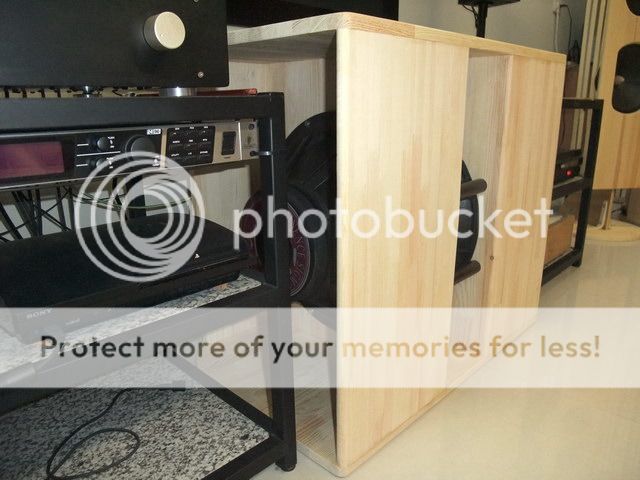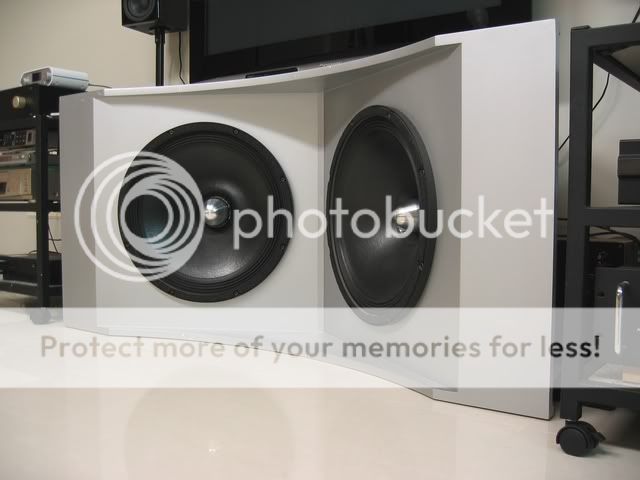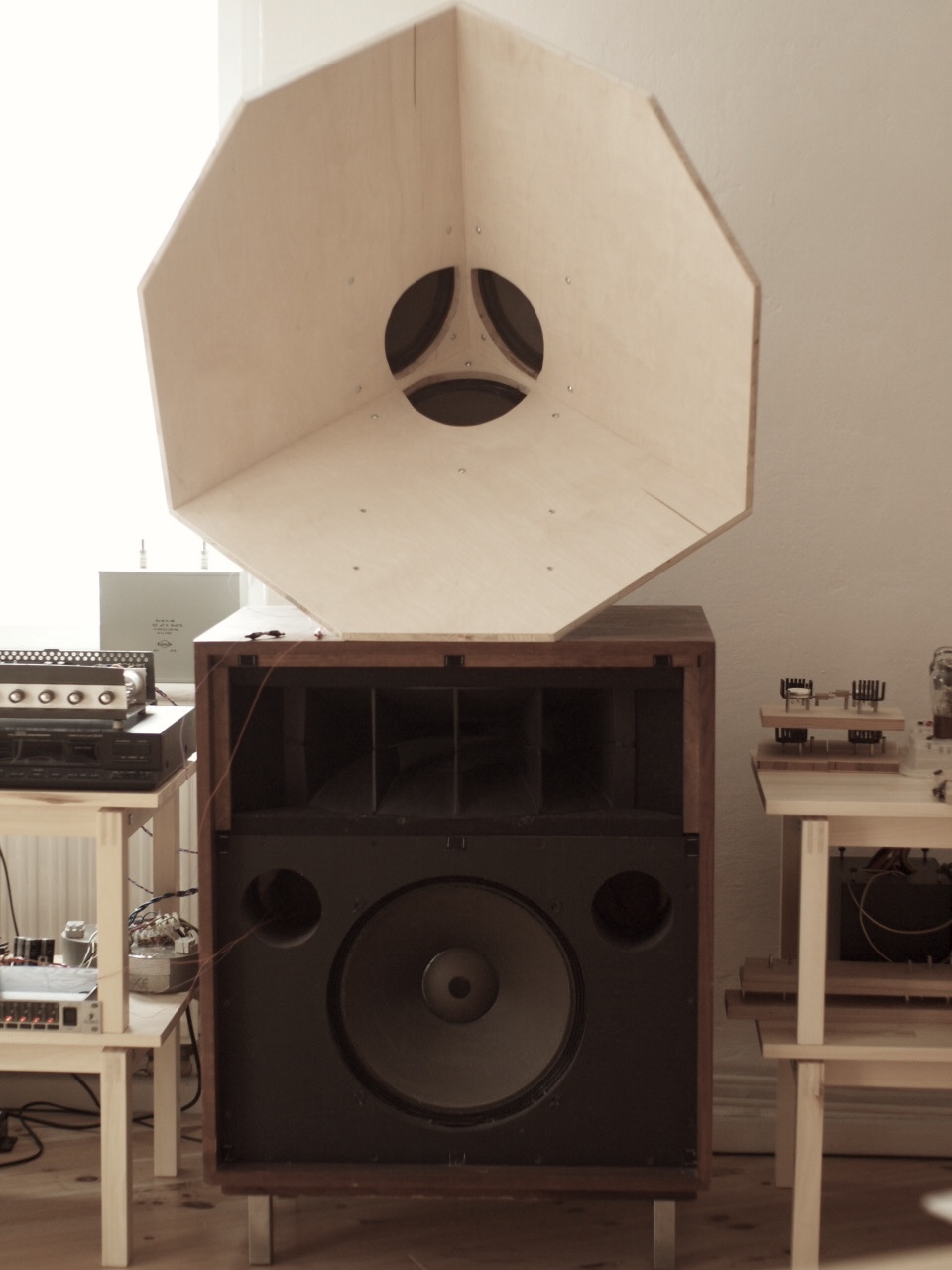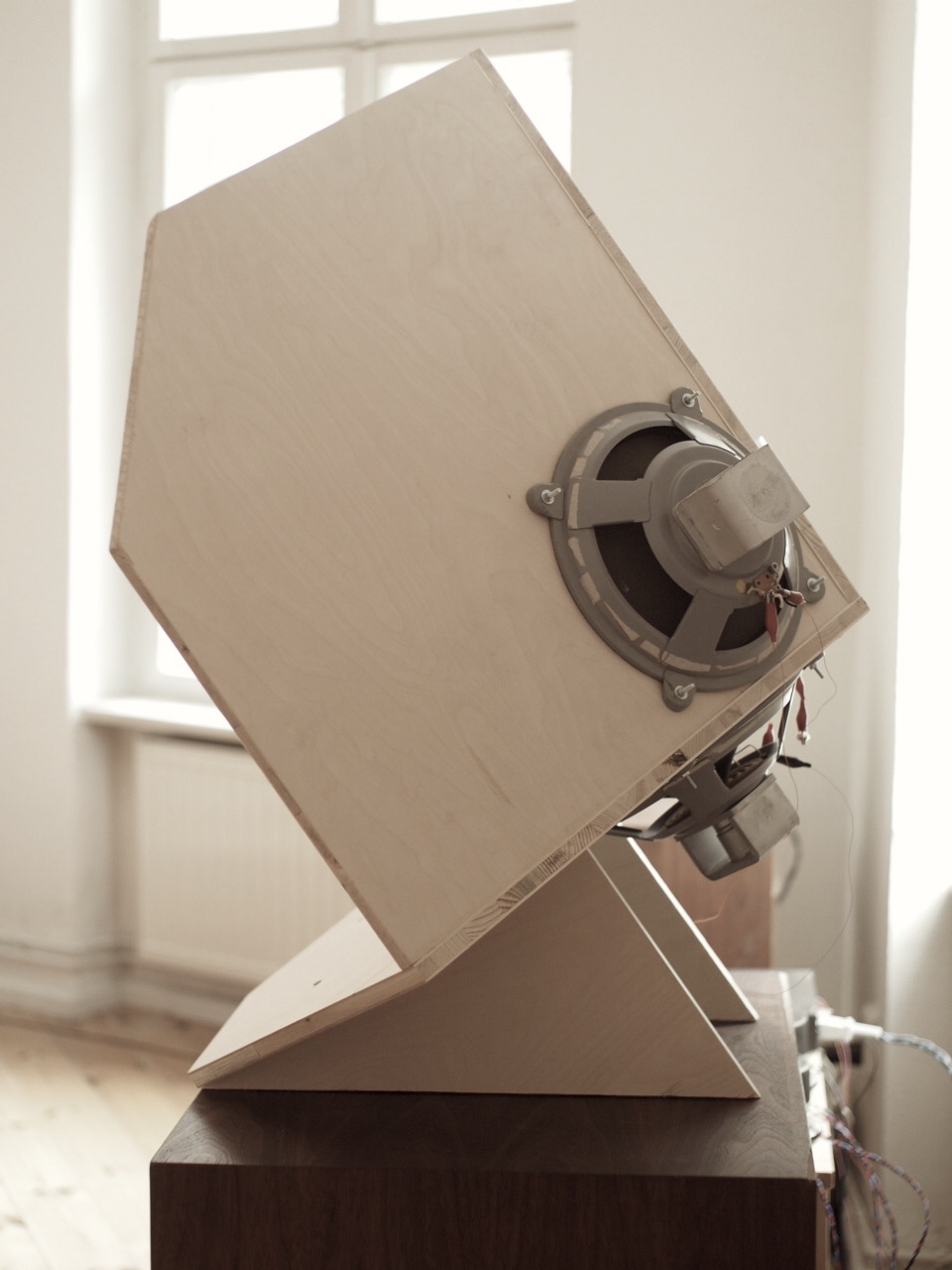Thanks for the links CLS. That "dice horn" is interesting!
The builder mentions:
"But yeah, conical; constant directivity; no parallel sides; only 90° joints; plane sides to mount drivers."
What are the downsides of the parallel sides? The previously illustrated horn has 50cm distance between the parallel sides and the planned upper freq limit is 500Hz (which has quarter wavelenght of ~17cm). Does this result in amplified resonances in the passband compared to, for example conical geometry?
The builder mentions:
"But yeah, conical; constant directivity; no parallel sides; only 90° joints; plane sides to mount drivers."
What are the downsides of the parallel sides? The previously illustrated horn has 50cm distance between the parallel sides and the planned upper freq limit is 500Hz (which has quarter wavelenght of ~17cm). Does this result in amplified resonances in the passband compared to, for example conical geometry?
Last edited:
Open back version radiation can not be dipole in theory. The horn makes attenuated spl and backside radiation is like quadripole - two dipoles in 90° angle. This same effect/pattern happens with conical drivers too, in a narrow band between dipole peak and dip.
Perfect dipole (theory) is based on flat driver membrane.
Perfect dipole (theory) is based on flat driver membrane.
Last edited:
Open back version radiation can not be dipole in theory. The horn makes attenuated spl and backside radiation is like quadripole - two dipoles in 90° angle. This same effect/pattern happens with conical drivers too, in a narrow band between dipole peak and dip.
Perfect dipole (theory) is based on flat driver membrane.
Do you mean intensified? Yes the construction is far from "school book" dipole, but to my eyes "quite" far from monopole also. I understand very well the monopole radiation @100Hz when a back chamber is used behind the woofers, but with open backed it strikes me as very odd. It might be just me
Last edited:
What are the downsides of the parallel sides? The previously illustrated horn has 50cm distance between the parallel sides and the planned upper freq limit is 500Hz (which has quarter wavelenght of ~17cm). Does this result in amplified resonances in the passband compared to, for example conical geometry?
Detriments to parallel sides are few.
The benefits are many. Ease of build is one primary factor. The benefit gained by a true conic is only applicable if you want a wideband dipole. Not realistic in the first place. 50 hertz is well into the range of human voice. A poor area to crossover to in a premium design. Now that you have polars for the lower frequencies the upper and mid frequencies are the areas of true importance. The bulk of musical content, as well as the important spatial cues of musical instruments reside in the lower midrange (200 hertz ) and up to about 4 khertz. So with what has been simulated I think you are on the right track.
Building this as a parabolic is fairly easy.
The midrange section is where all the real work is at.
Possible/optional iteration #2.
No parallel sides but still easy to put midrange horn onto it. Like this:
An externally hosted image should be here but it was not working when we last tested it.
No parallel sides but still easy to put midrange horn onto it. Like this:
An externally hosted image should be here but it was not working when we last tested it.
Detriments to parallel sides are few.
The benefits are many. Ease of build is one primary factor. The benefit gained by a true conic is only applicable if you want a wideband dipole. Not realistic in the first place. 50 hertz is well into the range of human voice. A poor area to crossover to in a premium design. Now that you have polars for the lower frequencies the upper and mid frequencies are the areas of true importance. The bulk of musical content, as well as the important spatial cues of musical instruments reside in the lower midrange (200 hertz ) and up to about 4 khertz. So with what has been simulated I think you are on the right track.
Building this as a parabolic is fairly easy.
The midrange section is where all the real work is at.
I share those same beliefs also regarding the XO points. I like to keep the xo freqs as low and/or as high as possible, gaining as much band in the midrange as possible. 2" compression driver is the real culprit, as they tend to like 500Hz xo at the lowest, even if the midrange horn is big (capable of ~200-300Hz xo). I have JBL 2446J's, which I intend to "truextentize" at some point. A 24-48dB/oct steep crossover is a possibility, but even then I doubt that 300-400Hz xo is completely viable when blasting it out, you know.
What would you pick, the parallel sided version #1, or the iteration #2 ? I think they are both fairly simple to construct and can be worked out in the modular construction like shown above. The possible sonic benefits aside, the iteration #2 might also look better in real life.
Last edited:
I share those same beliefs also regarding the XO points. I like to keep the xo freqs as low and/or as high as possible, gaining as much band in the midrange as possible. 2" compression driver is the real culprit, as they tend to like 500Hz xo at the lowest, even if the midrange horn is big (capable of ~200-300Hz xo). I have JBL 2446J's, which I intend to "truextentize" at some point. Even 24-48dB/oct steep crossover is a possibility, but even then I doubt that 300-400Hz xo is completely viable when blasting it out, you know.
Puzzling.
You strive for a cardioid in the low end, but not continuing up in the frequency range.
A little tip. At least in my experience there is no compression driver that does lower midrange ( for a proper crossover you would need to have an effective low end of at least 100 hertz ) with the combination of dynamic range and low distortion that works.
But there quite a few well designed midrange cone drivers out there that fit the bill and are well suited for horn use.
What would you pick, the paralleled sided version #1, or the iteration #2. I think they are both fairly simple(fixed the 'm') to construct and can be worked out in the modular construction like shown above. The possible sonic benefits aside, the iteration #2 might also look better in real life.
Choose your poison.
Sims are one thing. Listening and really measuring is quite another.
Last edited:
Puzzling.
You strive for a dipole in the low end, but not continuing up in the frequency range.
A little tip. At least in my experience there is no compression driver that does lower midrange ( for a proper crossover you would need to have an effective low end of at least 100 hertz ) with the combination of dynamic range and low distortion that works.
But there quite a few well designed midrange cone drivers out there that fit the bill and are well suited for horn use.
Choose your poison.
Sims are one thing. Listening and really measuring is quite another.
Sorry if I got confused with the dipole pattern wondering back there. My goal is speakers with cardioid pattern all the way, or quite close without sacrificing too much efficiency. That's why I have been discussing the flow resistance ports and so on.
I'm willing to make the sacrifice in the XO frequency, ie. use ~500Hz xo. I have heard Usher D2s (TAD TD4001 as the comp, xo'ed around 700Hz) and really liked them in the midrange dynamics department (still my reference in that regard). Also the clarity at high spl's was pretty awesome. It's almost ESL kind of clarity, but with seemingly endless capacity. I'm not sure any cone driver could ever achieve just the same.
My mistake.
Not dipole, cardioid!
Cardioid is the next most similar thing to horn-kind of directivity: both radiate the sound (almost) only to the front of the speaker. So one could speak of the intention to make almost solely front firing speakers.
Last edited:
An externally hosted image should be here but it was not working when we last tested it.
I would go with a slot loaded open baffle for the sub - kind of like the type CLS uses.

Or similar to the one Nelson Pass uses:

Or I wonder how this one sounds?

Last edited:
If ultimate high SPL is not needed (in domestic use, I suppose), then I agree with X that OB bass for sub is good.
Or, for the look, a similar open back V shape baffle is plausible. Make it slghtly bigger than the midbass one, and a pair of long stroke woofers, it'll still be very capable.
This was a shallow version I had used for a while:

Make it deeper and slot loaded, it'll be capable enough to rock the house.
Or, for the look, a similar open back V shape baffle is plausible. Make it slghtly bigger than the midbass one, and a pair of long stroke woofers, it'll still be very capable.
This was a shallow version I had used for a while:

Make it deeper and slot loaded, it'll be capable enough to rock the house.
If you do use foam core, I'd suggest a big roll-over (fold-back) at each side to reinforce the terminus. And it'll look like a big and beautiful gramophone.
.....
About the low end extension of such MB horn, I have had an interesting experience.
Back then when I bought the Oris 150, at first I didn't recieve all necessary mounting kit, so I couldn't install the driver properly.
I couldn't wait to play with it, I pulled another toy - Jordan Watt Flagon to mate with the new horns.
No securement mean whatsoever, I just put the Jordan on a small stool, with the horn throat more or less aligned with the driver, and the edge of horn mouth touched the floor. There's an ugly gap between the the throat and driver as there's no fixing. What the heck, I turned on the amp and volume nob, sat on floor very near the horns...
That's the most amazing leap in all of my audio experiences.
The Oris 150 is supposed to have a cut off frequency of 150Hz or so. And it's said it's not good using tractix horns all the way down to its cutoff because the loading is not ideal etc. However, on floor and loosely coupled with a wide-ranger, it produces pretty good bass.
I didn't feel any (relative) lacking in bass extension because of the enhancement of the midrange by horn. It still sounded very fullrange to my ears, with much much improved dynamics and details. OK, I know it's not really fullrange, maybe down to 50-60Hz at best, but the overall balance is very good nevertheless.
Maybe the nearfield listening also helps.
So, if the driver has enough stroke and can take some EQ, I think it's no problem producing enough bass to fill the room.
Small OB can do it anyway, why not some more folded baffle area?
My previous understanding of conical (i.e., all sides expanding like the inside of a four sided pyramid) has a quadratic area dependence with axial distance. But in Akabak, they use it to call a linear (or similar to HR "PAR") expansion. If you use PAR we can compare results if I use the "CONICAL" switch.
Hi xrk971,
Your previous understanding is correct
AkAbak simulates the hyperbolic-exponential Salmon family of horns, of which the conical (but not parabolic) horn is a member. The 'conical' switch is provided because the value of T is infinite for a conical horn. When the AkAbak manual says that "the cross-section increases linearly" for a conical horn, it is referring to the horn profile, not to the area expansion.
AkAbak cannot directly simulate a parabolic horn. A parabolic profile can however be approximated using multiple conical segments, if so desired.
Kind regards,
David
Last edited:
I would go with a slot loaded open baffle for the sub - kind of like the type CLS uses.

Or similar to the one Nelson Pass uses:

Or I wonder how this one sounds?

The capacity is somewhat a priority, I want to go to 15-20Hz without bottle necks.
I'm thinking 100cm deep heavily damped U-frame, terminated with flow resistance port at the mouth of the U-frame. Two long stroke 18 inchers per side.
An externally hosted image should be here but it was not working when we last tested it.
(picture snatched from Kimmo Saunisto's website mentioned in the OP)
1m deep U-frame corresponds to 4m x 4m big straight baffle, and has almost the same capacity as closed box @20Hz ("only" 4dB difference but very good considering it's OB) accoding to linkwitz's "spl_max1" excel sheet. The radiation pattern can be tailored cardioid/hypercardioid in the <100Hz band with a right amount of air flow resistivity.
Never heard a slot loaded baffle. I hear the slot's "gain" quickly diminishes when going 2-3m away from the slot? CLS, how's the bass's character different in slot loaded OB compared to similar sized or slightly bigger U-frame?
Does putting a shallow slot in front of the U-framed woofer tune the sound character more to the slot loaded direction? Like you have/had done with these:

Last edited:
Slot loaded does several things:
1. adding some more air load to the driver, lowering fs (on my woofer, 27Hz free air, 22Hz on flat baffle, 16Hz with slot in front of the baffle)
2. the small cavity forms some kind of bandpass effect
3. enlarging the path length, so it pushes the dipole loss slightly lower
4. if drivers are in pair(s), it gets possibility of push-pull and the even order distortion can be reduced
And yes the slot affects the dispersion, but we can ignore this in LF application. About the 'gain', I don't feel it very much.
Subjectively, the most important character I like about slot loaded is it brings back the strength of punch/slam/attack of bass sound -- the sense of weight and power. Dipole bass is clean but somewhat lacking of those. Slot loaded brings them back. I can't measure it, but it's there.
The CSA of the slot affects those effects quite directly. I settled on 40% of Sd after some trial and error. (too small, and it'd be overly heavy-footed, at least in my case)
As to deep U-frame, I have no experience. I would worry about the resonance of the parallel walls and the strong 1/4 wavelength of the cavity. I 'escaped' from the boxed speakers because of those, not to step back in anytime soon.
1. adding some more air load to the driver, lowering fs (on my woofer, 27Hz free air, 22Hz on flat baffle, 16Hz with slot in front of the baffle)
2. the small cavity forms some kind of bandpass effect
3. enlarging the path length, so it pushes the dipole loss slightly lower
4. if drivers are in pair(s), it gets possibility of push-pull and the even order distortion can be reduced
And yes the slot affects the dispersion, but we can ignore this in LF application. About the 'gain', I don't feel it very much.
Subjectively, the most important character I like about slot loaded is it brings back the strength of punch/slam/attack of bass sound -- the sense of weight and power. Dipole bass is clean but somewhat lacking of those. Slot loaded brings them back. I can't measure it, but it's there.
The CSA of the slot affects those effects quite directly. I settled on 40% of Sd after some trial and error. (too small, and it'd be overly heavy-footed, at least in my case)
As to deep U-frame, I have no experience. I would worry about the resonance of the parallel walls and the strong 1/4 wavelength of the cavity. I 'escaped' from the boxed speakers because of those, not to step back in anytime soon.
I agree with CLS' comments on slot loaded OB subs. Although my experience with them is with smaller array of 6.5 in drivers - the bass is natural sounding, has impact, and the box can be made quite compact - as the drivers are oriented 90 deg relative to baffle normal. Having the drivers in force canceling push pull also reduces distortion and box vibration. Having a 1 m long U frame will introduce a 1/4 wave mode that people try to avoid with OB, I think that is why U frames are normally less than 8 in deep. My sims of a slot loaded OB show that it helps to reduce the effect of dipole loss for a much smaller size.
100cm deep and 50cm tall/wide U-frame will introduce 1/4wl resonances at ~85Hz (lenght mode) and 170Hz (height/width mode). I would damp the whole back chamber, which would eliminate mentioned resonances given enough damping material. This (flow resistance) results in non-resonant/aperiodic system, that has almost non-peaky impedance even at driver's Fs.
With slot loading at least the front chamber is very tricky to damp, no? With 18 inchers that I have, the slot's 1/4wl resonance would be approx. at 170Hz since the slot would around 50cm deep and tall. Cardioidic polar response might also be harder to achieve? Maybe "ripole" kind of slot loading would be as easy as U-frame to achieve cardioid.
With slot loading at least the front chamber is very tricky to damp, no? With 18 inchers that I have, the slot's 1/4wl resonance would be approx. at 170Hz since the slot would around 50cm deep and tall. Cardioidic polar response might also be harder to achieve? Maybe "ripole" kind of slot loading would be as easy as U-frame to achieve cardioid.
Last edited:
Legis,
You have a good point there about the slot depth forming a resonant mode due to its 18 in depth. Let me model a 18 in a slot loaded OB and see what I get - this is interesting to me as I have only played with smaller 6.5 maybe 8 in drivers in the sims for the slot loaded OB.
X
You have a good point there about the slot depth forming a resonant mode due to its 18 in depth. Let me model a 18 in a slot loaded OB and see what I get - this is interesting to me as I have only played with smaller 6.5 maybe 8 in drivers in the sims for the slot loaded OB.
X
Last edited:
- Status
- This old topic is closed. If you want to reopen this topic, contact a moderator using the "Report Post" button.
- Home
- Loudspeakers
- Subwoofers
- Study of a Dipole/Cardioid Bass Horn

